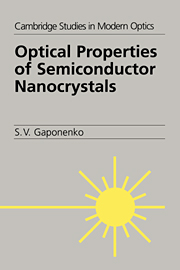Book contents
- Frontmatter
- Contents
- Preface
- 1 Electron states in crystal
- 2 Electron states in an ideal nanocrystal
- 3 Growth of nanocrystals
- 4 General properties of spectrally inhomogeneous media
- 5 Absorption and emission of light by semiconductor nanocrystals
- 6 Resonant optical nonlinearities and related many-body effects
- 7 Interface effects
- 8 Spatially organized ensembles of nanocrystals
- References
- Index
5 - Absorption and emission of light by semiconductor nanocrystals
Published online by Cambridge University Press: 09 October 2009
- Frontmatter
- Contents
- Preface
- 1 Electron states in crystal
- 2 Electron states in an ideal nanocrystal
- 3 Growth of nanocrystals
- 4 General properties of spectrally inhomogeneous media
- 5 Absorption and emission of light by semiconductor nanocrystals
- 6 Resonant optical nonlinearities and related many-body effects
- 7 Interface effects
- 8 Spatially organized ensembles of nanocrystals
- References
- Index
Summary
In this chapter we consider the optical processes in nanocrystals that can be interpreted in terms of creation and annihilation of a single electron-hole pair within a crystallite. Size-dependent absorption and emission spectra and their fine structures, as well as size-dependent radiative lifetimes, will be discussed for nanocrystals of II-VI, I-VII compounds and, where possible, for nanocrystals of III-V compounds and of group IV elements. Nontrivial aspects of excitonphonon interactions that manifest themselves in homogeneous linewidths and/or intraband relaxation processes will be outlined. Challenging experiments providing the optical information relevant to a single nanocrystal will be discussed as well. Most of these results have become possible because of a number of the spectrally and spatially selective techniques described in Chapter 4. An influence of a microcavity on spontaneous emission of nanocrystals, the competitive recombination mechanisms, and the electric field induced effects will be analyzed as well.
Size-dependent absorption spectra. Inhomogeneous broadening and homogeneous linewidths
Experimental evidence for quantum-size effects in real nanocrystals
In the early 1980s A. I. Ekimov and A. A. Onushchenko (Ekimov and Onushchenko 1982; Ekimov and Onushchenko 1984) and L. Brus with coworkers (Brus 1983; Rossetti, Nakahara, and Brus 1983) published pioneering articles in which size-dependent absorption spectra of semiconductor nanocrystals resulting from quantum confinement were demonstrated for the first time. During the same period S. V Gaponenko et al. reported on inhomogeneous broadening of the optical absorption spectra of glasses doped with semiconductor nanocrystals (Gaponenko, Zimin, and Nikeenko 1984).
- Type
- Chapter
- Information
- Optical Properties of Semiconductor Nanocrystals , pp. 84 - 152Publisher: Cambridge University PressPrint publication year: 1998
- 4
- Cited by



